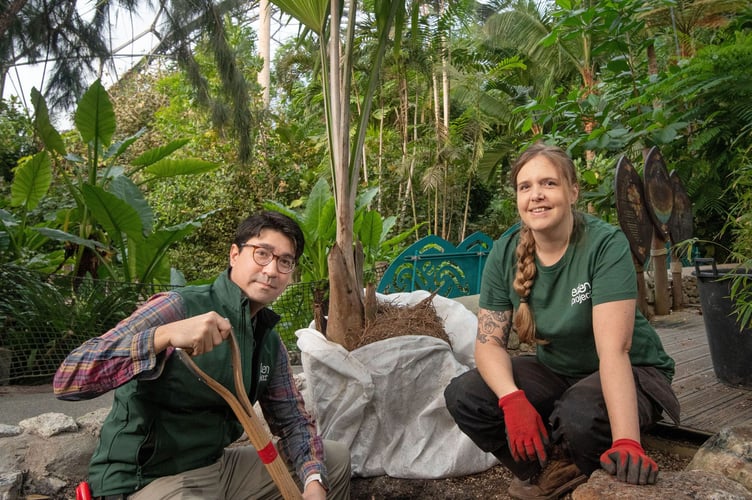AN example of an extremely rare species of palm, only discovered in 2006, has found a new permanent home in the Eden Project’s ‘Rainforest Biome’.
The palm, known as Tahina spectabilis, is native to the Analalava district — a very small, remote region in north-western Madagascar.
The area is less than five hectares in size, or approximately three times the size of the attraction’s biome. It is listed as ‘Critically Endangered’ on the IUCN Red List.

It is thought there are fewer than 40 mature plants growing in the wild and a very small number in cultivation in places such as Thailand, Costa Rica, Brazil, Venezuela and Mexico.
Having been discovered in late 2006, the new species to science was officially described in 2008 after photographs were sent to Kew Gardens and their scientists made a trip to Madagascar to identify it.
The distinctiveness of this rare palm meant that a new, unique plant genus — a category normally grouping similar plants together — was created just for this single species.
The palm, which is now the rarest plant in the Eden Project’s Rainforest Biome, had previously been grown at Cambridge University Botanic Garden, but needed to be relocated due to its size.
The garden donated the plant to the Eden Project as part of the charity’s ongoing conservation efforts.
Tahina spectabilis is the largest palm species from Madagascar and can be picked up on satellite imagery.
Its trunk is capable of growing up to 18 metres in height, with leaves reaching up to five metres in diameter.

The example seen at the Eden Project is currently approximately four metres tall and is thought to be up to 17 years old. Whilst little is still known to science about the palm, it is thought it will take a further 30 to 50 years to reach its full size.
The palm is monocarpic, meaning that the plant flowers and sets seed just once before it dies.
During this flowering event, the plant uses an incredible amount of energy to produce an impressive inflorescence with a vast number of small flowers. This behaviour is often seen in agaves but rarely in palms.
The inflorescence is a pyramid-shaped panicle that can grow four to five metres above the crown of the palm and consists of hundreds of three-flowered clusters. These clusters bloom in three consecutive, synchronised cohorts, attracting insects and birds for pollination.
The example at the Eden Project can be seen in the ‘Tropical Islands’ area of the Rainforest Biome, where the team have created a special bed to support the palm to grow to its full size.

Catherine Cutler, the Eden Project’s interim head of horticulture, said: “As horticulturists we are delighted that the Rainforest Biome is the new home for this magnificent palm, that we can play our part in the conservation of such an endangered species and that we, along with our visitors, can watch, and learn from it, as it grows.
“We are extremely proud of the collection of plants we have in the Biome, which sits at over 1,000 species and the eclectic stories they tell. There is so much for visitors to discover here and we are thrilled that this will offer another opportunity for them to experience a remarkable species that they wouldn’t normally have the opportunity to enjoy."

Luigi Leoni, Cambridge University Botanic Garden's glasshouse team leader, said: “It’s really exciting for the Tahina palm to be able to reach its full size at the Eden Project - something that wouldn’t have been possible in our Glasshouses at Cambridge University Botanic Garden.
"This will probably allow for this critically endangered species to flower and produce seeds in a few decades’ time. This will definitely be a first, since this Madagascan species was only described in 2008 and introduced to cultivation later on.”
Alongside the palm being planted for visitors to see in the Rainforest Biome, there will be a plethora of things to enjoy at the Eden Project this October half-term.
The Eden Project's ‘Halloweden’ season will be taking place from October 26 and November 3 and will include activities that will take visitors on a deep dive into the extraordinary world of creepy crawlies great and small, including magnificent minibeast shows, a mega-beast safari and a bug fair.
Alongside the Halloweden programme, October half-term also sees the return of the Eden Project’s popular ice rink.





Comments
This article has no comments yet. Be the first to leave a comment.